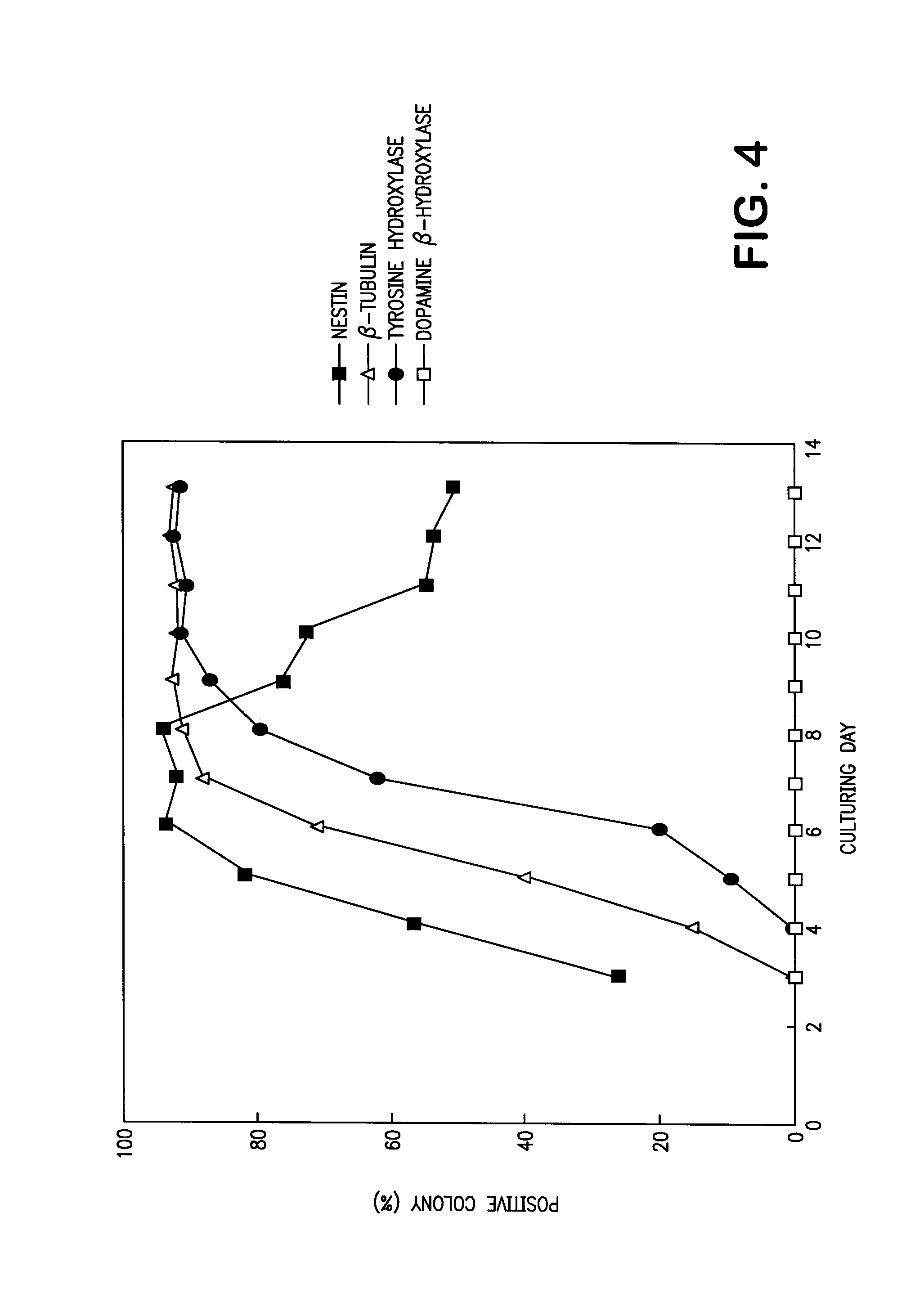Process of inducing differentiation of embryonic cell to cell expressing neural surface marker using OP9 or PA6 cells
a technology of neural surface marker and embryonic stem cells, which is applied in the field of inducing the differentiation of embryonic stem cells into functional cells, can solve the problems of difficult use of obtained cells in transplantation, inability to efficiently induct a specified cell, and gradual attenuation of the effect of many patients, who will then suffer from side effects
- Summary
- Abstract
- Description
- Claims
- Application Information
AI Technical Summary
Benefits of technology
Problems solved by technology
Method used
Image
Examples
example 1
Differentiation of Embryonic Stem Cell into Dopaminergic Neuron
[0404]An embryonic stem cell, ES cell EB5 (H. Niwa et al., Nature Genet., 24, 372 (2000); obtained from Dr. Niwa at Department of Molecular Applied Medicine, Medical School of Osaka University) was cocultured with a stroma cell, MC3T3-G2 / PA6 cell (H. Kodama et al., J. Cell Physiol., 112, 89 (1982), hereinafter referred to as “PA6 cell”), or with a mouse fetal primary culture fibroblast (hereinafter referred to as “MEF cell”).
[0405]Since the ES cell EB5 is gene-transferred in such a manner that a drug-resistant gene blastocidine-R is expressed in downstream region of an undifferentiation-specific promoter (Oct3 promoter; E. Pikarsky et al., Mol. Cell. Biol., 14, 1026 (1994)), undifferentiated ES cell alone can be selected and maintained by culturing it by adding 20 μg / ml of blastocidine. The ES cell EB5 was used in the present invention after confirming that it survived and maintained the undifferentiated state during the...
example 2
Differentiation of Embryonic Stem Cell into Non-Neuroectodermal Cell
[0421]A medium was produced by adding 0.5 nmol / l BMP4 (manufactured by R & D) to the serum-free medium described in Example 1. The ES cell EB5 was cocultured with PA6 cell according to the method described in Example 1, using the thus produced BMP4-added serum-free medium instead of the serum-free medium used in Example 1. Eight days after culturing, immunological cell staining was carried out using the anti-NCAM antibody, the anti-nestin antibody or an antibody against a non-neural ectoderm cell marker E cadherin (manufactured by Takara Shuzo). As a control, coculturing was carried out using the serum-free medium without BMP4. The results are shown in FIGS. 5A, B, C, D, E and F.
[0422]Also, 8 days after culturing using the BMP4-added serum-free medium, the medium was changed to Glasgow MEM medium containing 10% fetal bovine serum (manufactured by GIBCO BRL), followed by culturing for 3 days. The thus cultured cells ...
example 3
Selection of Stroma Cell Having Activity of Inducing Differentiation of Embryonic Cell into Dopaminergic Neuron
[0425]ES cell EB5 was cocultured with PA6 cell, MEF cell, STO cell, NIH / 3T3 cell, OP9 cell, CHO cell, MDCK cell, 3Y1 cell or COS cell (hereinafter referred to as “respective cells”).
[0426]The STO cell was cultured according to the method described by Evans et al. (M. J. Evans et al., Nature, 292, 154 (1981)). The NIH / 3T3 cell was cultured according to the method described by Jainchill et al. (J. L. Jainchill et al., J. Virol, 4, 549 (1969)). The OP9 cell was cultured according to the method described by Nakano et al. (T. Nakano et al., Science, 272, 722 (1996)). The CHO cell was cultured according to the method described by Puck et al. (T. T. Puck et al., J. Exp. Med., 108, 945 (1985)). The MDCK cell was cultured according to the method described by Misfeldt et al. (D. S. Misfeldt et al., Proc. Natl. Acad. Sci. USA, 73, 1212 (1976)). The 3Y1 cell was cultured according to t...
PUM
| Property | Measurement | Unit |
|---|---|---|
| Cell angle | aaaaa | aaaaa |
| Surface | aaaaa | aaaaa |
Abstract
Description
Claims
Application Information
 Login to View More
Login to View More - R&D
- Intellectual Property
- Life Sciences
- Materials
- Tech Scout
- Unparalleled Data Quality
- Higher Quality Content
- 60% Fewer Hallucinations
Browse by: Latest US Patents, China's latest patents, Technical Efficacy Thesaurus, Application Domain, Technology Topic, Popular Technical Reports.
© 2025 PatSnap. All rights reserved.Legal|Privacy policy|Modern Slavery Act Transparency Statement|Sitemap|About US| Contact US: help@patsnap.com



